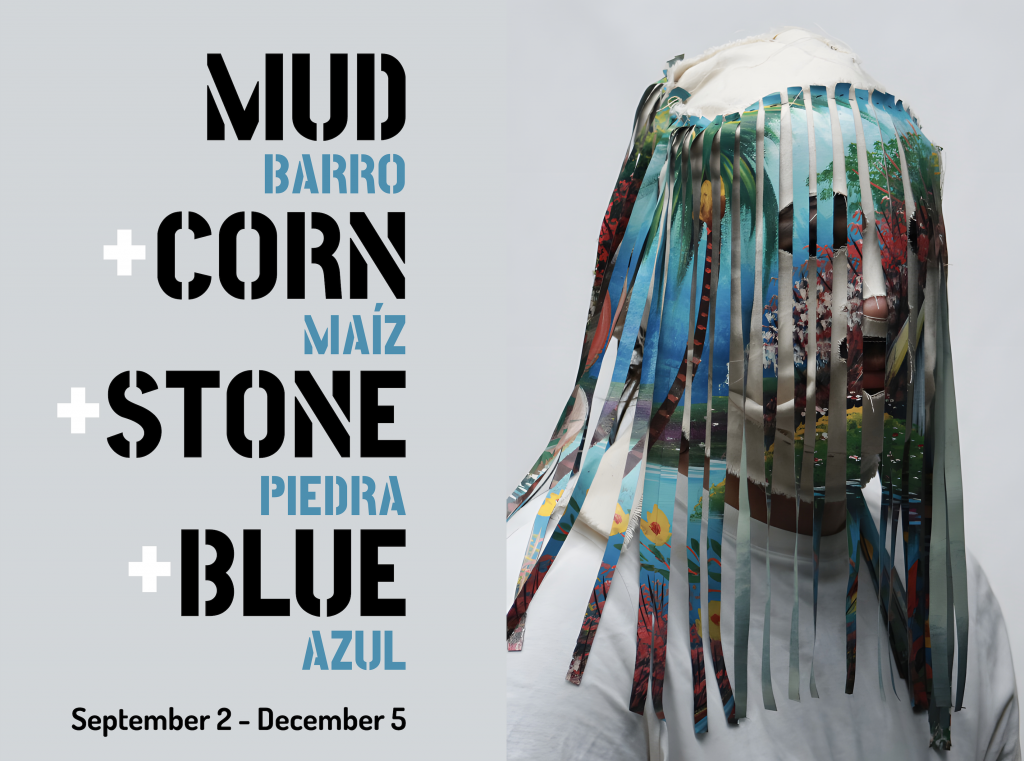
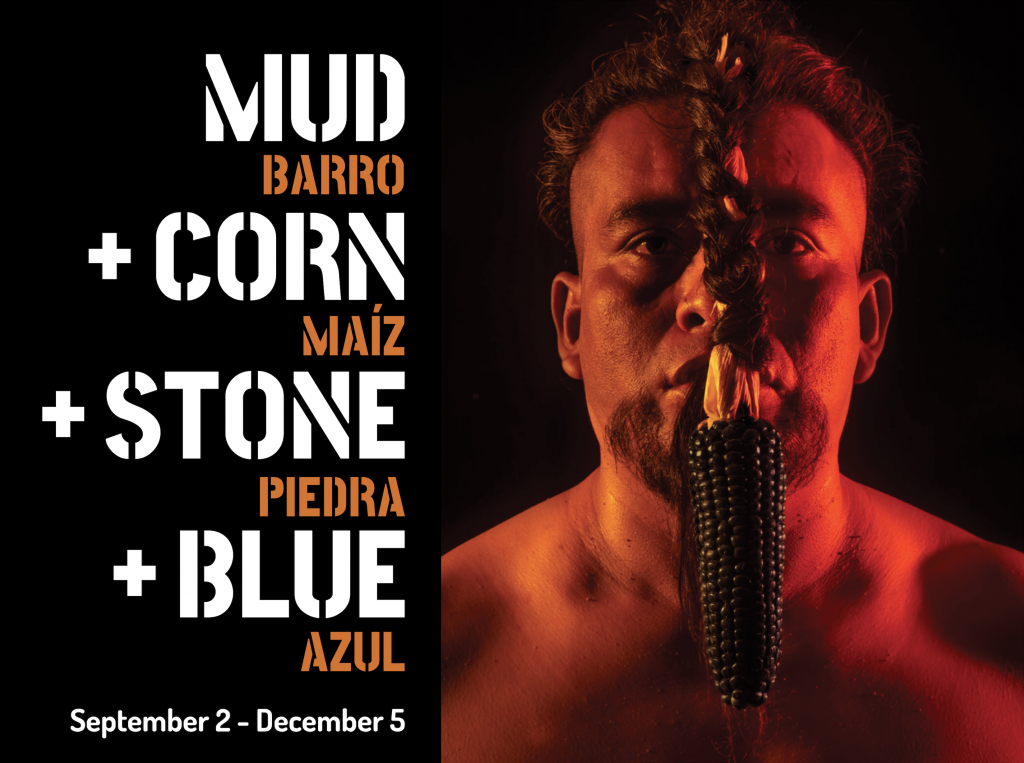
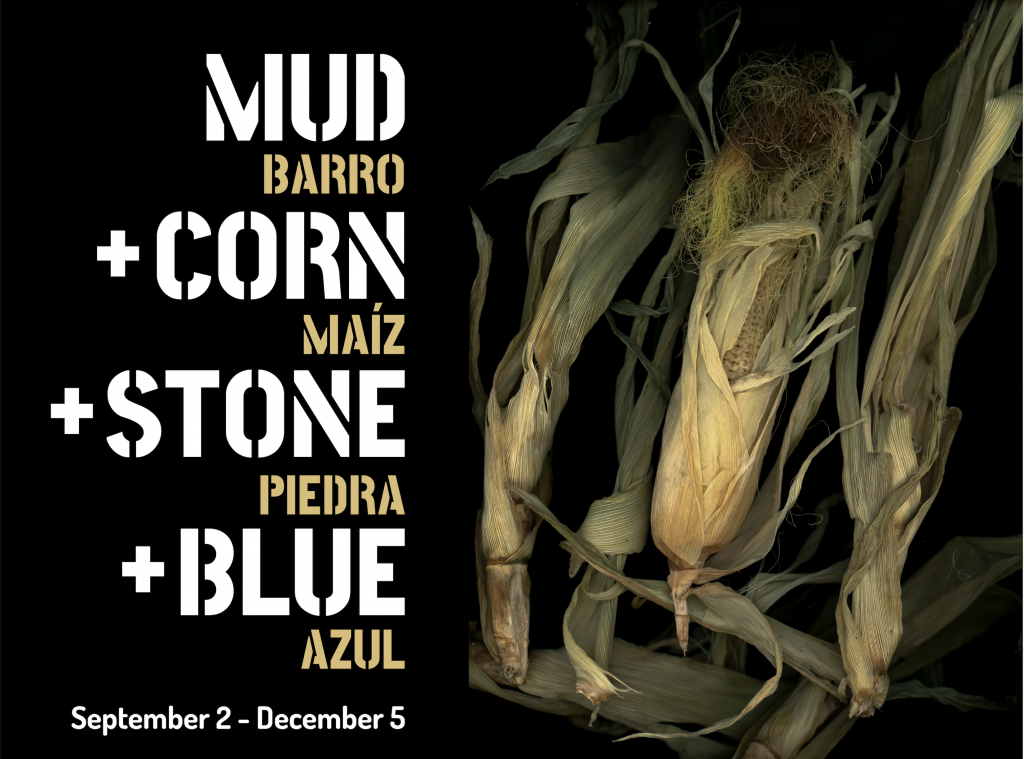
Curated by Laura Augusta PhD
Told through a constellation of places and temporal back-and-forths, Mud + Corn + Stone + Blue traces stories of the entangled lands of the United States and Central America. The traveling exhibition hinges on major conflicts that have scarred the region since the 1960s and how their histories are entwined with that of U.S. agriculture through the corn industry. These conflicts include armed engagements in Guatemala (1960-1996), El Salvador (1980-1992), and Nicaragua (1979-1990); U.S. interventions in Honduras in the 1980s; and even the Tractorcade (1979) in the U.S. Corn Belt, when farmers drove more than 900 tractors to Washington, D.C. in protest of Cold War agricultural policy that had devastated small family farms across the Plains and Midwest. Across its long timeline, the exhibition centers on the years 1979-1981 to illustrate the overlap between the U.S. farming recession and the worst years of the armed conflicts in Central America, and how they are grounded in the same political and economic decisions around farming practices, ideas of land ownership and stewardship, migrant labor, and agricultural export.
Mud + Corn + Stone + Blue includes artwork from the U.S. Corn Belt and from Guatemala, Nicaragua, El Salvador, and Honduras. For the artists (many of whom have witnessed these events firsthand), it is important to make visible the connections between the natural world, agricultural reform, economic recession, military intervention, civil war, genocide, and mass migrations. These entanglements resist national borders and leap across time to connect disparate experiences when, since much of the artwork made during these crises has disappeared, artists rely on their own familial experience to fill in the gaps. Where there are holes, absences, and intractable silences in these histories marked by intertwined traumas—by grief, by mistranslation, by forgetting—artists engage in speculation to imagine the acts of sharing that might have been.
Rather than chronological or national groupings, works on view are organized in organic relationships with an archival throughline that commingles their complex political and agricultural histories. As the exhibition travels, Augusta continues the practice of convivencia (shared living) inscribed within her curatorial methodologies by engaging in context-specific acts of collaboration and conversation—including archival research, meetings with artists and community groups, and learning from activists—to better understand each place’s ties to this history.
About the Curator
Laura Augusta, PhD, is the Jane Dale Owen Director & Chief Curator at the Blaffer Art Museum at the University of Houston. Her recent exhibitions include Mud + Corn + Stone + Blue (2024-2026), Presentiments (2024), Adán Vallecillo: Tiempo Libre (2024), Proving the Hypothesis of Celestial Flirtation: Christin Apodaca (2023-2024), Jessica Kairé: Levantamiento (2023), Laura Turón: Immersive Abstractions (2023), Here, And the Wind (2023), Sam Reveles: Solastalgia (2022), On Porous Edges & Radical Decay (2021, online), Touch Over Fear (2021, online), Stone’s Throw: Arte de Sanación, Arte de Resistencia (2020), To Weave Blue: Poema al Tejido (2020), and To Look at the Sea is to Become What One Is (2019), among others. Her work has been awarded Fellowships from the Andy Warhol Foundation, the Mellon Foundation, the Core Critical Studies Program at the MFAH, and Yale University, among others, and her essays have been widely published internationally, in English and Spanish. She has actively published arts criticism in Texas since 2005. From 2016-2020, Laura ran a domestic project space, Yvonne, in her apartment in downtown Guatemala City. Laura’s curatorial/essay projects connect the landscapes of disaster-prone places, thinking specifically about storms and muddiness, shared space, and everyday forms of embodied ongoingness.
Mud + Corn + Stone + Blue is a traveling exhibition curated by Laura Augusta, PhD. It is produced by Independent Curators International (ICI), New York in collaboration with the Stanlee & Gerald Rubin Center for Visual Arts at The University of Texas at El Paso. Mud + Corn + Stone + Blue is made possible with the generous support of ICI’s Board of Trustees and International Forum. It is supported in part by the National Endowment for the Arts. Exhibition graphics by Untitled Agency, Marrakech.
The presentation and programs at the Stanlee & Gerald Rubin Center for Visual Arts at The University of Texas at El Paso are supported by The Andy Warhol Foundation for the Visual Arts and The Mellon Foundation.
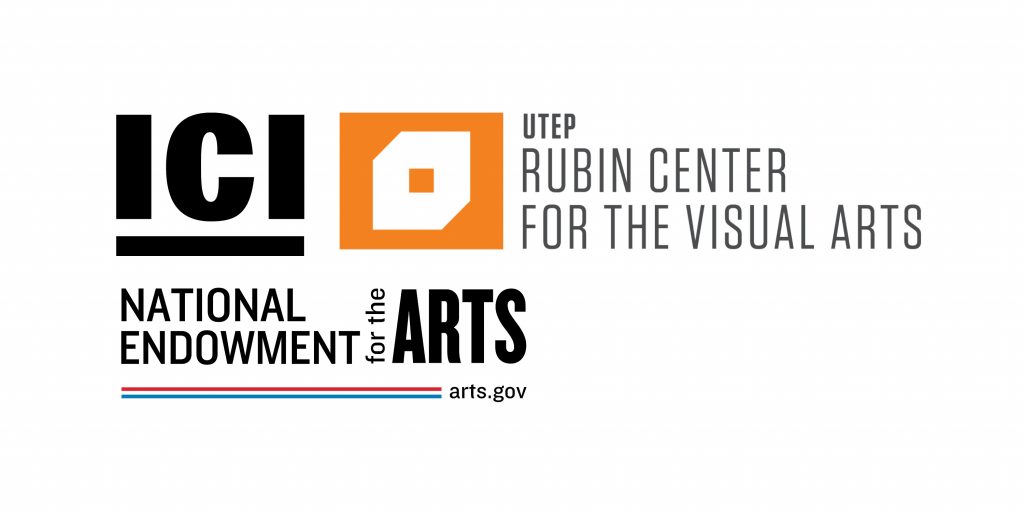
Cultivating Hope through Community and Resistance
Programs for Mud+Corn+Stone+Blue at the College of Wooster Art Museum
Please join us as we explore the themes of our fall exhibition Mud+Corn+Stone+Bluethrough programs that celebrate agricultural traditions and heritage, share more about the context of the migration crisis, and build community as we cultivate hope and resistance together. All programs will be held at the museum unless otherwise specified. Art Museum exhibitions and programs are always free and open to the public.
Mud + Corn + Stone + Blue Opening Celebration
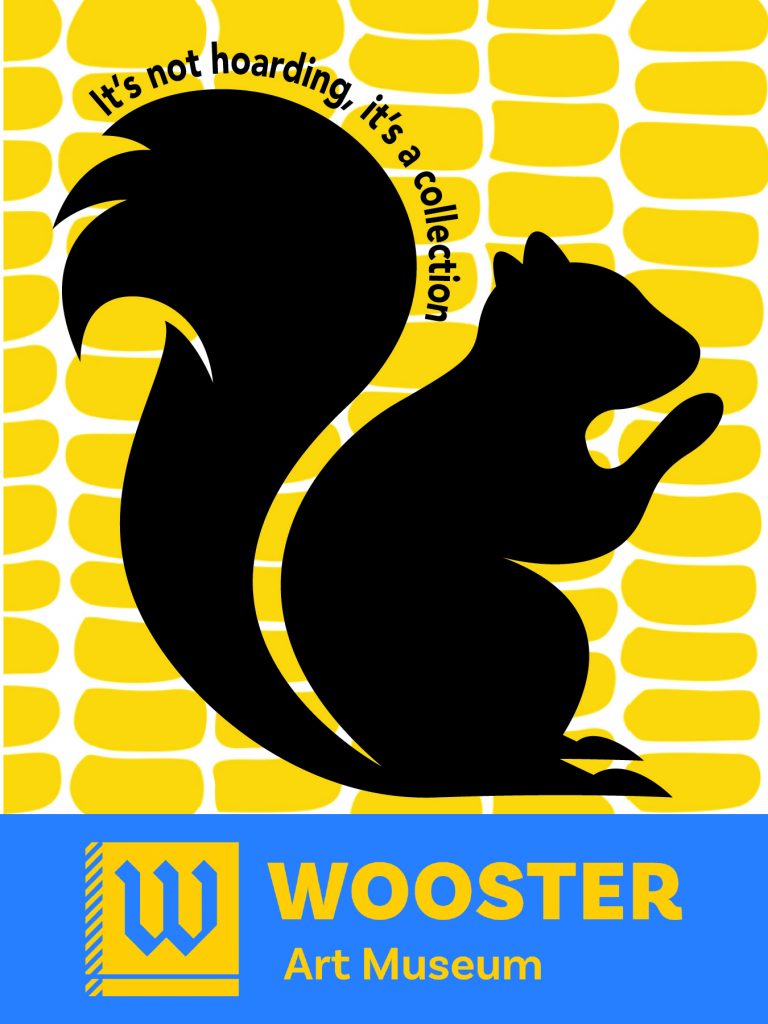
September 9, 4 – 6 pm
Come celebrate the opening of our fall exhibition with themed activities and treats. Get grounded for the semester ahead by painting a rock and use native plants to create your own blue sunprints to celebrate Ohio; play cornhole, make your own dirt pudding, and mix your own custom popcorn flavor at our popcorn buffet.
Video Screening
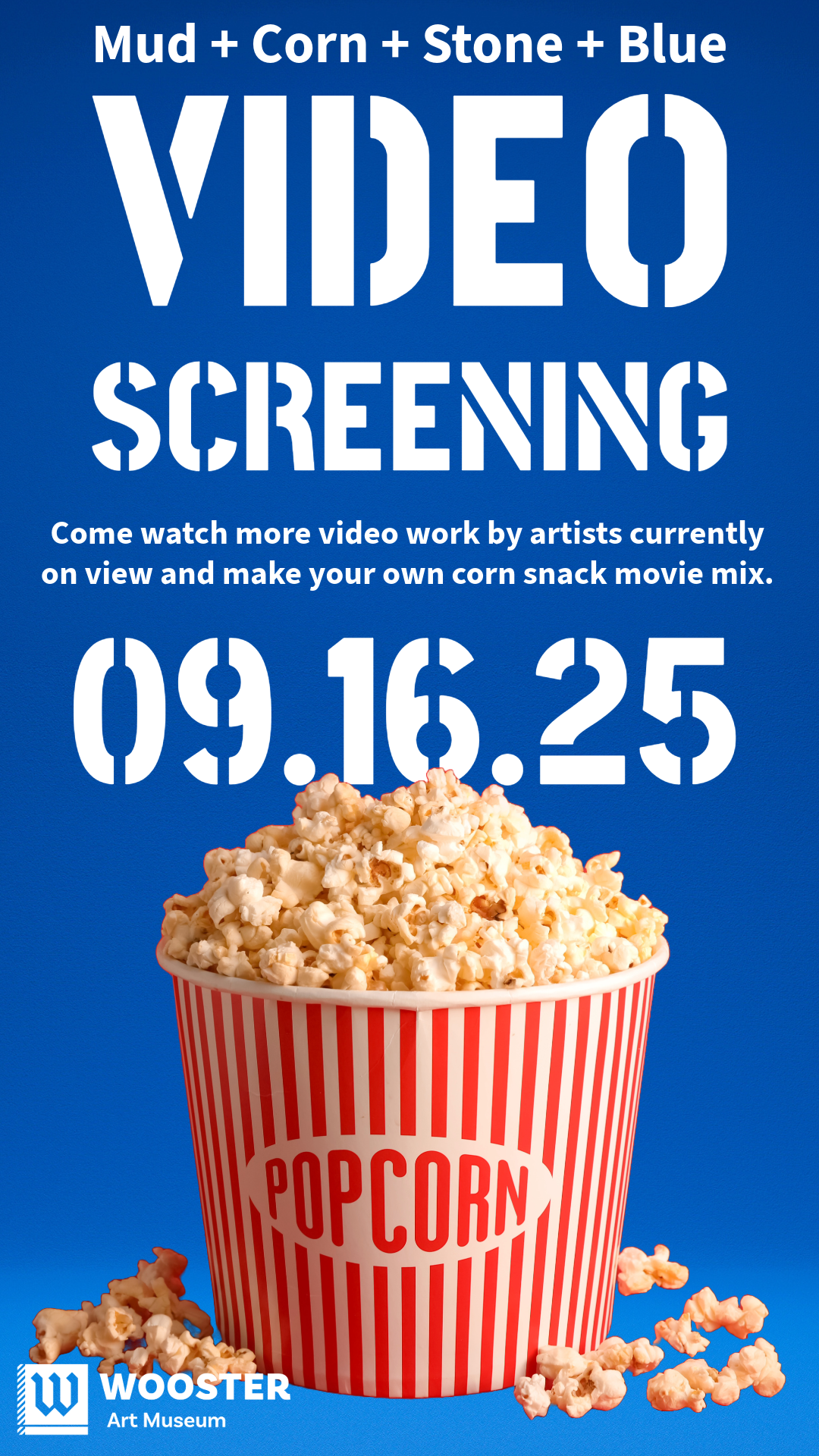
September 14, 4 – 6 pm
Come watch more video work by artists currently on view in Mud + Corn + Stone + Blue and make your own corn snack movie mix.
Silent Book Club
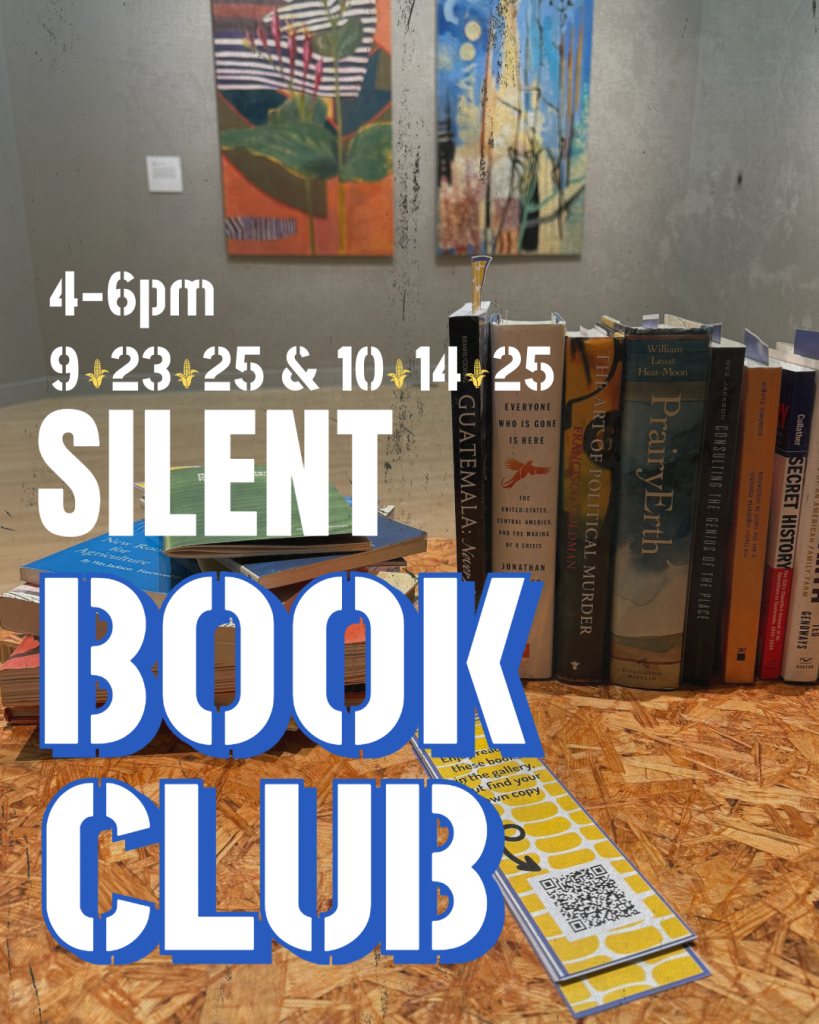
September 23 & October 14, 4 – 6 pm
Mud+Corn+Stone+Blue travels with a small library of books related to themes in the exhibition. Settle into a beanbag chair with a book for a quiet time and grab a corn-themed snack to go.
Mud + Corn + Stone + Blue Reception and Curator’s Talk
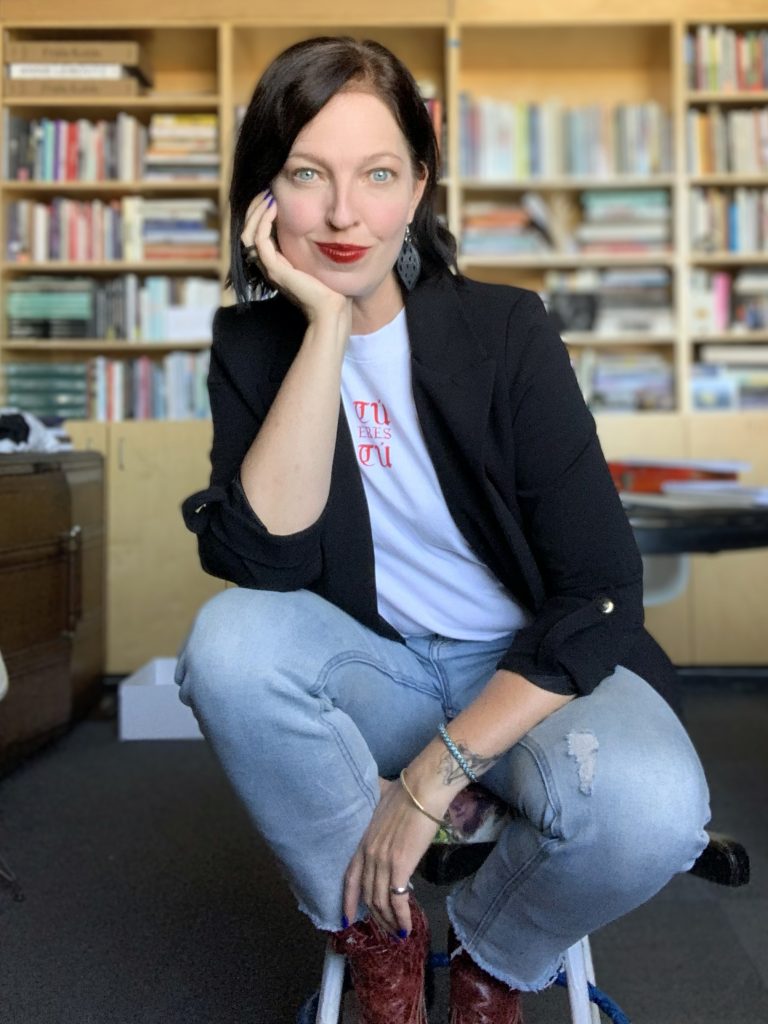
September 30, 4 – 6 pm Reception beginning at 4 pm with talk starting at 4:45 pm.
Join Laura Augusta, curator of Mud + Corn + Stone + Blue, to learn more about the exhibition themes and artworks.
Laura Augusta, PhD, is the Jane Dale Owen Director & Chief Curator at the Blaffer Art Museum at the University of Houston. Her work has been awarded Fellowships from the Andy Warhol Foundation, the Mellon Foundation, the Core Critical Studies Program at the MFAH, and Yale University, among others, and her essays have been widely published internationally, in English and Spanish. From 2016-2020, Laura ran a domestic project space, Yvonne, in her apartment in downtown Guatemala City. Laura’s curatorial/essay projects connect the landscapes of disaster-prone places, thinking specifically about storms and muddiness, shared space, and everyday forms of embodied ongoingness.
It’s CORN! A Staff and Faculty Corn Potluck
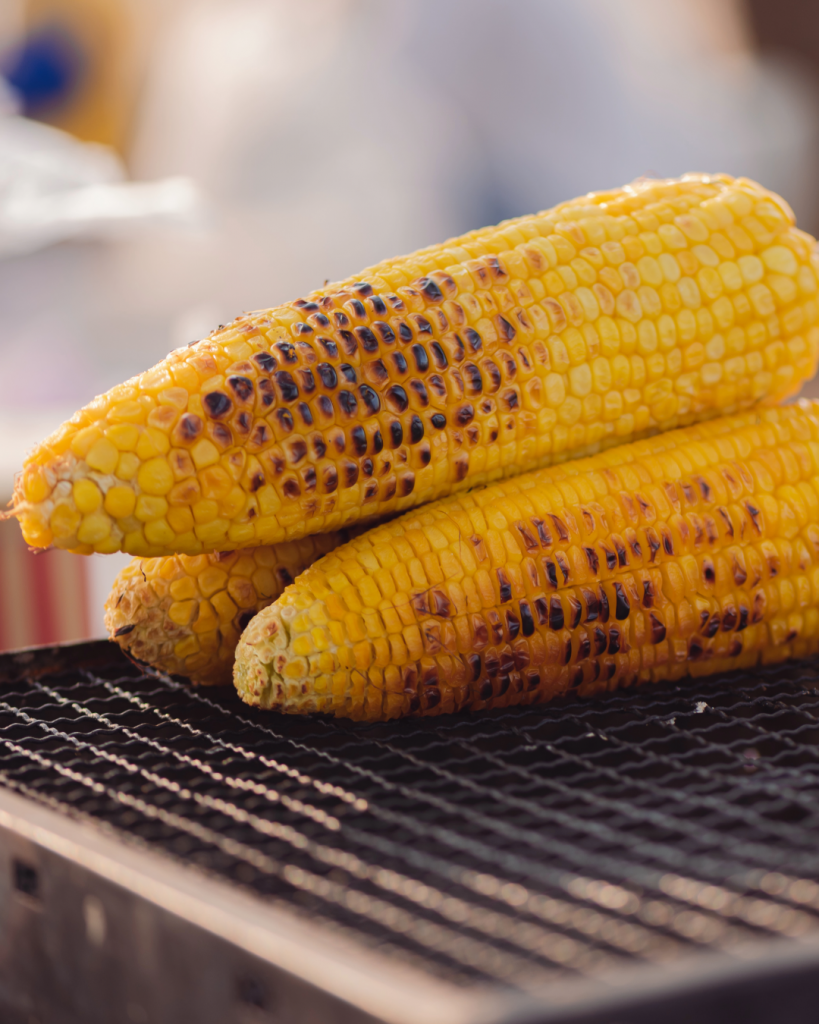
Friday, October 10, 12 – 2 pm
Join us at the end of fall break to celebrate all things CORN with a corn-themed potluck and celebrate our community corn cookbook collaboration!
Bring your favorite corn dish to share.
And remember to email us your recipe for the cookbook! (artmuseum@wooster.edu)
Mayan Community Garden Project Panel Discussion

Sunday, October 19, 2 – 4 pm
Join us for a tour of the exhibition and a panel discussion about the importance of land, language, and culture in their communities of origin and in their resettled communities here in Ohio. Central American foods will be catered by the Immigrant Worker Project AMIGAS co-operative.
Litigating for Liberation with OCSILiO
Sunday, Friday, October 24, 6:30 pm
Westminster Presbyterian Church Mackey Hall 19, 2 – 4 pm
Learn more about OCSILiO’s mission in action in defending detained Ohio immigrants in their high-stake deportation proceedings “….rooted in the belief that no one should be imprisoned for seeking safety.” Hear from OCSILiO Executive Director, Brian Hoffman, plus first-hand stories from OCSILiO staff, College of Wooster Interns, and immigrants defended by OCSILiO, with Q/A to follow. Enjoy Central-American finger foods provided by Immigrant Worker Project AMIGAS co-operative. Free-will offerings for OCSILiO will be accepted (with gifts of time and talent also appreciated).
The Ohio Center for Strategic Immigration Litigation and Outreach (“OCSILiO” – pronounced “auxilio”) was formed in 2020 as the first litigator-founded nonprofit legal services organization in Ohio focused primarily on clients seeking release from detention. OCSILiO recognizes that the current immigration crisis in the United States is as much a problem of democracy as it is of litigation, and welcomes the opportunity to address the public about relevant topics in the rapidly developing field of immigration law and prospective reforms. Many of Attorney Hoffman’s clients enjoy the opportunity to participate in public outreach events as well, and their experiences and images have been featured in media ranging from local community theater productions to the covers of United Nations publications.
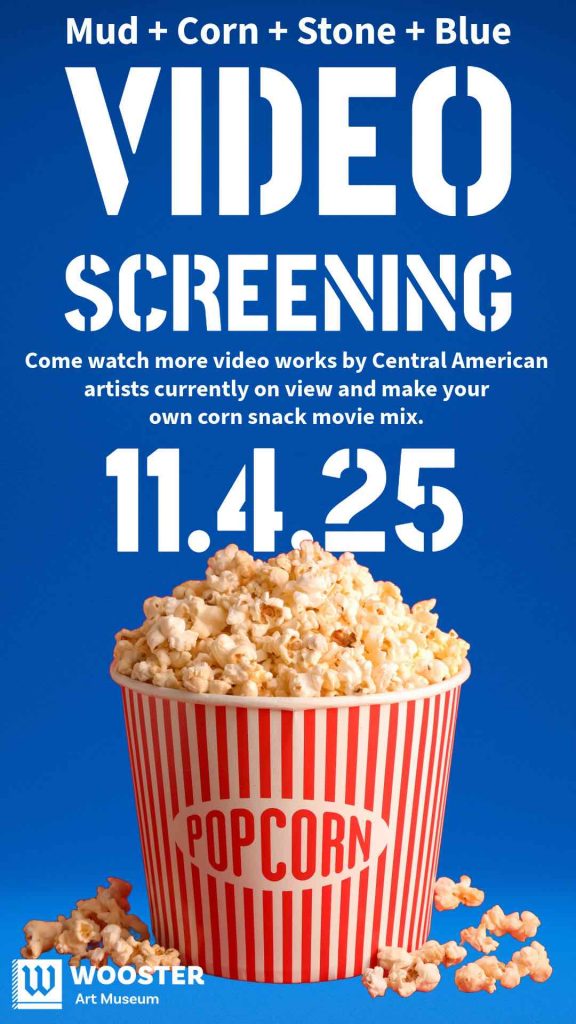
November 4, 4 – 6 pm
International Education Week! Come watch more video work by artists currently on view in Mud + Corn + Stone + Blue and make your own corn snack movie mix.

The Politics of Birth Work: How a 7th Century Snake Queen of Waka‘ Projected Authority through Birth Work as Conjuring Magic
Tuesday, November 11, 4pm, Ebert 223
Professor Navarro-Farr explores mortuary offerings associated with Waka’s most powerful 7th Century Queen and discusses how these objects convey the powerful link between sex, fecundity, and birthing as conveyances of conjuring magic and divinatory power.
Anthony Almendarez
Anthony Almendarez is an artist and composer working with sound, improvisation, performance, video, photo, and writing. His work challenges the hierarchy between audio and visual stimuli, undermining their respective stereotypes in relation to how we interpret and internalize our surroundings, by exploring modes of storytelling that confront audiences with the nuanced, layered, and complex realities of how we construct identity. Almendárez’s work has been presented nationally and internationally including at CIRCA, London, UK; Seen:Sound Visual/Music, Melbourne, Australia; ECHOFLUXX 19, Prague, Czech Republic; Conservatoire Maurice Ravel, Paris, France; Bard College, Annandale-on-Hudson, NY; Experimental Sound Studio, Chicago, IL; Miami New Media Festival; Artpace, San Antonio; Aurora Picture Show; Blaffer Art Museum; Alabama Song; Nameless Sound, and Lawndale Art Center, Houston, TX. He is the recipient of artist grants from YES Contemporary and the City of Houston through the Houston Arts Alliance. Writing on his work has been featured in publications including Moving Image Art London, The Invisible Archive Journal, Voyage Houston, and Glasstire. Born and raised in Los Angeles, Almendarez is currently based in Houston where he is an Administrative Coordinator and Artist Facilitator for Nameless Sound, and Musical Director for TEATRX. He received his BA in Music Education from California State University, Dominguez Hills; MA in Music Theory and Composition from Marshall University; and the MFA in Music/Sound from Bard College.
Francis Almendárez
Francis Almendárez is an artist, filmmaker, and educator from South Central, Los Angeles. His work takes many different forms including collaborations, performances, screenings, workshops, and exhibitions that have been presented in museum, university, arts nonprofit, artist-r
un, virtual, and DIY spaces both nationally and internationally. Through the merging of history, autoethnography, and cultural production, his works offer ways to navigate and reconcile with intergenerational trauma, and reclaim diasporic identities. Recent presentations include screenings at Miami New Media Festival, Cité Internationale des Arts, Paris and LOOKING FORWARD, London; DIY photography and filmmaking workshops in Honduras and El Salvador; public photo-murals at FotoFest, Houston; and a collaborative performance at Antenna, New Orleans. Almendárez is an Assistant Professor of Photography/Video and Studio Art at California State University San Bernardino, and previously lectured at University of Houston School of Art and Houston Community College. He received his MFA (with Distinction) from Goldsmiths, University of London, and BFA in Sculpture/New Genres from Otis College of Art and Design.
Edgar Calel
Edgar Calel (Chi Xot -San Juan Comalapa-, Guatemala, 1987) studied at the Escuela Nacional de Arte Rafael Rodríguez Padilla. He works in a variety of media, exploring the complexities of the indigenous experience, as seen through the Mayan Kaqchikel cosmovision, spirituality, rituals, community practices, and beliefs, in juxtaposition with the systematic racism and exclusion that the indigenous people of Guatemala endure on a daily basis. His most recent solo exhibitions included: Ni Musmut (It’s Breezing), Bergen Kunsthall, Oslo, Norway, Kutenten – kutenten – kutenten at Mendes Wood DM, Archipelago, New York, USA and Ru Raxal qa Rayb’äl (The Green of Our Desire) at La Nueva Fábrica in Santa Ana, Antigua Guatemala. In 2023 had his first institutional solo show B’alab’äj (Jaguar Stone) at SculptureCenter. In 2021 had his first solo Pa Ru Tun Che ́ (From a Tree Top) at Proyectos Ultravioleta, Guatemala City. Additionally, he has participated in numerous group exhibitions including El espacio en medio. Visiones del arte indígena en el mundo (The Space in Between. Visions of Indigenous Art in the World), MAMM, Medellin, Colombia (2024); The Way of the Water, Tangente St.Pölten, Austria (2024); Radical Playgrounds: From Competition to Collaboration, Berliner Festspiele, Berlin, Germany (2024); Choreographies of the Impossible, 35th São Paulo Biennial, São Paulo, Brazil (2023); uMoya: The Sacred Return of Lost Things, 12th Liverpool Biennial, Liverpool (2023); Soft and Weak Like Water, 14th Gwangju Biennial, Gwangju (2023); Is It Morning for You Yet?, 58th Carnegie International, Pittsburgh (2022); The Crack Begins Within, 11th Berlin Biennial, Berlin (2020); Los Jardineros (The Gardeners), Proyectos Ultravioleta, Guatemala City (2020); Continuous Fire | Feu continuel, National Gallery of Canada, Ottawa, Ontario (2019); Virginia Pérez Ratton. Centroamérica: Deseo de lugar / Centra America, MUAC Museo Universitario de Arte Contemporáneo, Mexico City (2019).His works are part of the permanent collections of Rijkscolectie-National Collection of the Netherlands; Hammer Museum, Los Angeles, USA; Tate, UK; Museo Nacional Centro de Arte Reina Sofía, Madrid,Spain; the National Gallery of Canada, Ontario; Fundación TEOR/ética, San José, Costa Rica; MADC Museum of Contemporary Art and Design, San José, Costa Rica; and Kadist, San Francisco. Additionally, he has participated in artistic residencies including Tropical Papers (2021); Residencia Rua do Sol, Portugal (2019), and at Lastro research platform, Brazil, 2015), amongst others.
Benvenuto Chavajay
Benvenuto Chavay is a mixed media artist, performer, and community activist. He lives and works between Guatemala City and San Pedro La Laguna. Benvenuto graduated from the National School of Plastic Arts (ENAP) in Guatemala City (2000). He received a scholarship to study at the National University of Costa Rica (2002) and at EspIRA / La ESPORA Escuela Superior de Arte in Nicaragua (2007). He is co-founder of the Tzun-Ya Collective in San Pedro La Laguna, Atitlán, Sololá, and coordinator of the Chi-Yá Festival of Art and Culture of San Pedro La Laguna. He has presented his work in various solo shows and group exhibitions in Guatemala and abroad. His work is part of important collections such as El Museo del Barrio in New York, the Museum of Latin American Art-MOLAA in Long Beach, and the Museo Reina Sofia in Madrid.
Oscar Rene Cornejo
Oscar Rene Cornejo is an artist who was born in Houston, Texas, and splits his time between New York and Western Massachusetts. With a background in pedagogy and activism, Cornejo’s socially engaged practice draws together histories of abstraction in the U.S. and Latin America with personal experiences of the construction site, family memory, and historical reconciliation. He earned an M.F.A. from the Yale School of Art, a B.F.A. from The Cooper Union, and was a recipient of the J. William Fulbright Scholarship for research in El Salvador. In 2004, he co-founded the Latin American Community Art Project (LA CAPacidad), an artist residency advocating for intercultural awareness through community art education. He is a founding member of Junte Adjuntas, an artist project based in Adjuntas, a town in the mountains of southern Puerto Rico. He has attended the Skowhegan School of Painting and Sculpture, Lower Manhattan Cultural Council’s Workspace Residency, and Yvonne Residency in Guatemala. Cornejo has taught at The Cooper Union, Hunter College, and Yale School of Art’s Painting and Printmaking Department. During the summer season, he is the Fresco Instructor at the Skowhegan School of Painting and Sculpture.
Manuel Chavajay
Manuel Chavajay’s work transits through various bi-dimensional, installation, and audiovisual formats. As a Mayan Tz’Utujil artist, he seeks to construct images, actions, and objects that take on poetic forms of the denouncement and vindication of his culture. His personal history, like that of a large percentage of Guatemalans, is pierced by the violence of armed conflict, of which he and his family were direct victims. Together with other indigenous artists of his generation, Chavajay conceives contemporary art as a space of healing. His work refers to the wisdom of practices and spirituality linked to the Mayan worldview: a profound connection with nature and the energy present in things, which reflect both specific beliefs as well as ways of life that have resisted the material and symbolic threats of a globalized world. Between 2009 to 2021, Chavajay has participated in various group and individual exhibitions in Guatemala, México, Bolivia, Colombia, Ecuador, United States, Scotland, Nicaragua, Brazil, Czech Republic, Canada, the Museum of Contemporary Art Santa Barbara, Cosmopolis # 1.5 Enlarged Intelligence in collaboration with the Centro Pompidou, Chengdu, Àbadakone Continuous Fire Feu continuel, National Gallery of Canada, and Kunsthalle Wien 1 Viena as well as in biennials such as Biennial SIART Bolivia, Biennial CURITIVA BRASIL, the seventh Biennial of Visual Arts of the Central American Isthmus BAVIC, and the Arte Paiz Biennials. His work is featured in public institutions including the Ortiz Gurdian museum in Nicargua, Reina Sofia in Spain, the art collection of the inter-American Development Bank NY, and the National Museum of Ottawa Canada in addition to private collections.
Text by Alexia Tala
Alejandro De La Guerra
Alejandro De La Guerra is a multidisciplinary artist, drummer, and teaching artist. Born in Managua, Nicaragua, lives and works between New York City and Managua, Nicaragua.De La Guerra addresses the aestheticization of power, collective memory, and monumental languages of public space, using the Performance, Sculptures, Video, Masks, and Relational aesthetics, through an exploration of violence and healing, art-activism, and, relations of power on human relationships. De La Guerra was part of the first art generation of Space for Artistic Research and Reflection (EspIRA). He is a co-founding member of the cultural zone temporary autonomy for Nicaragua and Central America Malagana-Mácula, and has participated in three Central American Biennials. Alejandro been participated in Residencies at the Josef & Anni Albers Foundation; Rosekill Art-Farm, Residency Unlimited RU, with the support of Artistic Freedom Initiative AFI, Westbeth, New York, The Artist Protection Fund with the support of SFA and El Instituto of UCONN; URRA in Buenos Aires, Argentina; Câmera Sete Casa da Fotografia de Minas Gerais in Belo Horizonte, Brazil; and RAPACES in Central America.
Leonardo Gonzalez
Leonardo González lives in Tegucigalpa, Honduras. He is an artist, cultural manager and curator since 2003. He is currently director and co-founder of “LL Proyectos”; an independent project dedicated to producing contemporary art projects in Honduras. He has been part of international artists residencies such as Art OMI and Fountainhead. He studied Fine Arts at the National School of Fine Arts in Tegucigalpa, Honduras and has a Bachelor degree in Social Communication. It focuses on experimental and collaborative projects, independent research and promotion of Central American contemporary art. He was awarded the travel and research grant from Foundation for Arts Initiatives (FfAI). He has participated in the III Biennale of Casablanca in Casablanca, Morrocco, the 56ª International Art Exhibition of the Venice Biennale, Venice, Italy. His work has been shown in Mexico, USA, Canada, Guatemala, Belize, El Salvador, Cuba, Dominican Republic, Peru, Argentina, Uruguay, Paraguay, Colombia, Spain, Switzerland among others.
Melissa Guevara Gonzalez
Melissa Guevara received her degree in visual arts with an emphasis in ceramics at the University of El Salvador. Guevara lives and works in El Salvador, where she is a member of The Fire Theory, an El Salvador-based art collective. Her practice is born out of an interest in the historical and personal significance of symbols as well as personal reflections, discomforts, fears, and beliefs that translate into visual experiences. Guevara has participated in a number of programs and residencies such as Chicicaste, Panajachel, Guatemala, Campos de Gutiérrez, Medellín, and Taller 7 in Medellín. Her recent solo exhibitions include “No moriré del todo,” at the Teatro Luis Poma in San Salvador, “Conjunciones Ilusorias,” at the galería Lokkus Arte Contemporáneo in Medellín, and “Antropometría” at the Centro Cultural de España in San Salvador. Her work has also been included in group shows such as “Perspectivas Latinas #18” at the Städtischen Galerie in Wolfsburg, Germany, “AL DICTADO. Arte y conflicto en Centroamérica” at the Museum of Modern Art in Medellín, and “Declaración Negada Proyecto de The Fire Theory” at the Museo de Arte de El Salvador among others
Lorena Molina
Lorena Molina is a Salvadoran multidisciplinary artist, educator and curator. She is an Assistant Professor of Photography and Digital Media in the School of Art at the University of Houston. She’s also the founder and the director of Third Space Gallery, a community space and gallery that supports and highlights BIPOC artists in Cincinnati.Through the use of photography, video, performance and installation, she explores identity, intimacy, pain, and how we witness the suffering of others. The work interrogates relationships and the formation of relationships as political acts that are guided by negotiations of power and privilege. At the core of her work is an exploration of spatial inequalities and the challenges that oppressed groups face in constructing place and establishing a sense of belonging. The work is driven by a deep sense of displacement experienced after a 12-year-old civil war forced her and her family to migrate to the United States. Most of her work stems from a need to find and build community in a way that it’s both tender, accountable, challenging through difficult conversations that makes everybody involved actively question their position and privileges in society. Her current work looks at identity in the margins. She views the margins both as a place where extreme violence and pain happens, but also as a place for resisting, dreaming, healing, and thriving. She received her Master of Fine Art degree from the University of Minnesota in 2015 and her Bachelor of Fine Art from California State University, Fullerton, in 2012. Molina has been a recipient of the Diversity of Views and Experiences fellowship, The Christopher Cardozo Fellowship, (Two) Truth and Reconciliation grant from Artswave, The Idea Fund, and The Kala Art Institute fellowship. She has exhibited and performed both nationally and internationally, such as the Contemporary Art Center, Cincinnati, The Kemper Museum, Southeast Museum of Photography, 621 Gallery, The Carnegie, Covington, KY, Vox Populi, FSU Museum of Fine Arts, EXPO Chicago, The Armory, The Delaplaine Art Center, The Beijing Film Academy and all over the piazzas of Florence, Italy. In the classroom, she works with students to understand the way that images are laden with history and vocabulary. Images tell stories, but who gets to tell the story matters
Tesora Molina-Garcia
Tesora Garcia (she/her) is a Salvadoran-American media artist, writer, and educator whose work is here to dismantle the violence of the Global North. A citizen of the Global South and an American Dreamer, Tesora’s research–drawing from various threads in immigration politics, philosophies of madness, and nonwestern esoteric spirituality–aims to explore how structural violence shapes personal and collective experience. A co-founder of Becoming Sticky, a lens-based collective of Central American photographers in the diaspora, Tesora uses a mixed-media approach that combines creative writing, critical theory, and experimental photography to unsettle fixed systems of value and artistic inquiry. Tesora’s work, through novel approaches like insect reiki and games in collective consciousness, is dedicated to the emancipation of bodies, thought, and land. Tesora holds an MFA degree in Photography & Extended Media from the California Institute of the Arts (CalArts), dual degrees in Photography and Art History from the University of North Texas, and currently serves as Assistant Professor of Photography and Digital Futures at Virginia Commonwealth University in Richmond, VA, where she is teaching the next generation of experimental media artists and thinkers.
New Farmers Project
New Farmers is an interdisciplinary collaborative art/research project that brings together a visual artist, rural sociologist, graphic designer, and a host of independent farmers to tell the story of a new breed of contemporary farmer — the first-generation, small-scale, sustainable farmer.Much like their subjects, the project’s fieldwork methodology is based in open process of collaborative naiveté — essentially working alongside one another, simultaneously influencing and learning from the other. In actively maintaining an open and supportive process, the photographs, interviewing strategies, theoretically informed questions, and pattern making combine with design and conversation to make sense of the hopes and hurdles of new farmers.
- D. Bryon Darby (b. 1979) was born and raised in the high-desert mountains of northern Utah where he received a BFA in Graphic Design from Utah State University (2001) and an MFA in Photography from Arizona State University (2011). Central to Darby’s creative work is the relationship between place and meaning. Darby investigates perceptions of place as mediated through culture, technology, and experience and uses photography as a means to question and engage with the unfolding world. He currently resides in Logan, Utah where he is Photography Coordinator and Lecturer of Photography at Utah State University.
- Paul Stock (b. 1979) was born and raised in St. Louis, MO. His B.A. in Sociology and Anthropology (2001) from Truman State University in northeastern Missouri. After completing his Ph.D. in sociology from Colorado State University(2009), Paul researched dairy and sheep farmers in New Zealand as a post-doctoral researcher at the University of Otago. With an interest in interdisciplinary and collaborative work, New Farmers explores the experiences of farmers, families, and communities related to relationships with each other and the natural world. Currently, Paul is an Assistant Professor in Sociology and the Environmental Studies Program at the University of Kansas.
- Tim Hossler As the former in-house art director for renowned editorial photographer Annie Leibovitz, Tim Hossler helped Ms. Leibovitz create her most memorable images, books and exhibitions of the late 90’s through the early 2000’s. Hossler holds a degree in Architecture from Kansas State University (1993) and a MFA from Cranbrook Academy of Art (2005). He was the Director of Design at the Massachusetts Museum of Contemporary Art (MASS MoCA) and the Art Director of The Wolfsonian-Florida International University in Miami Beach. Hossler currently teaches visual communications and photo culture at the University of Kansas. His research is focused on working with artists, photographers and cultural institutions to create narrative work. In 2011/2012 he collaborated with British fashion photographer Tim Walker and art director Ruth Ansel to create Walker’s book and exhibition Story Teller (Muir et al., 2012).
Sandra Monterroso
Sandra Monterroso began her artistic career in performance art in 1999. She earned a B.A. in Graphic Design in 2001 followed by an M.A. in Design from Universidad Popular Autónoma del Estado de Puebla (UPAEP) in Puebla, Mexico. In 2020, Monterroso earned a PhD in Art Practice from the Akademie der bildenden Künste Wien in Vienna, Austria. She has represented Guatemala in more than twelve biennials, including the 56th La Biennale di Venezia, the 12 Bienal de La Habana, and the Frestas – Trienal de Artes in São Paulo. Monterroso lives and works in Guatemala City.
In her work, Monterroso explores the dynamics of indigenous culture in the postcolonial era, gender issues, and other constructs of power across media including tapestry, painting, video, installation, and performance. Her influences include Cindy Sherman (USA), Gina Pane (France), Carolee Schneemann (USA), Ana Mendieta (Cuba), and Marina Abramović (Serbia), as she explores issues of identity and relational dynamics between genders and cultures. As Monterroso explains, “Behind the silence and the paradox of modernity and coloniality, I start taking as a symbolic reference more particularly the Mayan Q’eqchi’ language as an inheritance from mygrandmother, whose linguistic structure is completely metaphorical.”
Monterroso has shown her work in selected exhibitions around the world, including the Bienal de Artes Visuales del Istmo Centroamericano (BAVIC), Museo de Arte de ElSalvador (Museo MARTE), San Salvador, El Salvador (2006); Indigenous Voices, La Biennale di Venezia, Padiglione America Latina-IILA, Venice, Italy (2015); Art-Action Feministe: Panorama de la vidéo-performance féministe contemporaine latino- américaine, Centre Pompidou, Paris, France (2009); Cosmópolis II, Centre Pompidou, Paris, France (2019); To Weave in Blue, Poema al Tejido, The Martha and Robert Fogelman Galleries of Contemporary Art, University of Memphis, Tennessee, USA (2020); and Visionarios, Museo Nacional Centro de Arte Reina Sofía (MNCARS), Madrid, Spain (2009).
Moe Penders
Moe Penders is a Salvadoran artist, whose practice is mainly framed in traditional photography. They moved to Houston in 2009 to attend the University of Houston where they received their BFA in Photography and Digital Media and are currently completing their MFA at UC San Diego. Their work explores the social construction of home, intersectionality of identity and gender expression. Recently Moe has been developing maps which explore translation within cuirnes and migration
Angel Poyón
Poyón is an important voice of the experimental contemporary art movement in Central America. Departing radically in execution from the traditional artistic expression of his indigenous background, Poyon’s pieces nonetheless probe assimilation and identity.
Angel Poyón lives and works in Comalpa, Guatemala where he was born. He believes that his work is not limited to creation but to truly connect with the “Rajawal” (spirit) of the object itself, it is in this way that the object intervened becomes a work of art.
In Poyón’s culture any object is submitted to a ritual, especially those that are close to people. The objects have a spirit that needs to be found. When this happens there is a union between the object and the person who uses it; it is a relation that transcends the matter and is a channel where both parts connect and accompany each other in a lasting relationship.
Poyón applies this idea of finding the spirit’s object to conceptual art; he explains that, if the spectator allows himself to enter into the energetic space of the conceptual artwork and find its spirit then he will be able to understand it because he won´t be seeing the piece with his eyes but with his mind. He reminds us that conceptual art is an invitation to think, to question what is being put in front of us.
Fernando Poyón
Guatemala, 1982.Lives and works in Comalapa, Guatemala. Fernando Poyón can be defined by his desire to communicate social, cultural, historical and political life through the experimentation of contemporary media and techniques. His work has been included in exhibitions such as “Aquí estamos,” Km O.2 Gallery, Colección Poyón, El Lobi, Puerto Rico, 2017. Salón Internacional de Arte Indígena Manuel Quintín Lame, Popayán Cauca, Colombia. ArtFlow Gallery, Costa Rica, 2016. I Bienal Internacional de Asunción de Paraguay. “Guatemala Después”, The New School Nueva York – Quetzaltenango, Guatemala. Arco, Madrid España, 2015. “Colección Poyón”, 19 Bienal de Arte Paiz, Ciudad de Guatemala. “Mayafabergé”, El Nuevo Museo de Arte Contemporáneo (NuMU), Guatemala. “Estado de Excepción”, Arte Actual, Flacso, Quito, Ecuador, 2014. Festival Videoarte Barcelona. “Situaciones Creadas”, CCE, Costa Rica. Arte Actual en Guatemala. Centro Párraga Murcia, Spain. Arco, Madrid Spain. T20 Gallery, Murcia, Spain, 2013. Zona Maco, México DF. “Así que se Valla”, Ciudad Imaginación Quetzaltenango, Kamin, Comalapa Guatemala 2012, “Hoja Blanca” Zúrich y Guatemala. Casa Museo “Lino Enea Spilimbergo”, Unquillo, Córdoba, Argentina. “Sin título”, Fundación TEOR/éTica, Universidad de Costa Rica 2010. “Mi cuerpo es un Arma” I Bienal Denver Colorado, Memento Morí Gallery, (e)Star Lima, Peru. XVII Bienal de Arte Paiz, Guatemala 2010. La Mancha de Tomate, Tegucigalpa, Honduras. “Estrategias para medir el Universo” Sol del Río Gallery, Guatemala 2009. Landing 8 Fine Arts Museum, Tai Pei, Taiwán, “Pintura proyecto Incompleto”, Cooperación Española, La Antigua Guatemala, “Horror Vacui” Guatemala 2008. “Landing 7”, Haydee Santa María, La Habana Cuba, “Landing 6”, Casa de las Américas, La Habana, Cuba 2007. V Bienal de Artes Visuales del Istmo Centroamericano, El Salvador 2006, “Landing 5”, Museo de Arte de Las Américas, Washington DC.
James Dean Pruner
Kansas painter, printmaker, draftsman, zinemaker, sculptor, and poet James Dean Pruner (1951-1987/1988) was at the center of a vibrant artist community in Kansas in the 1970s and 1980s. After studying at Emporia State University, he moved to rural Stafford County, where he converted a Cincinnati city bus into his studio, and made work that explored the intertwining of humans, animals, and the land. His colleagues and friends—artists, activists, farmers, poets, and musicians—gathered there for April Fools’ Day parties, for star-gazing, for music-making, and for conversations about land stewardship, art, and politics. Pruner believed in small-scale farming as an antidote to the influences of mass culture and capitalism in the early 1980s. His counter-cultural activism and community organizing is only one example of the breadth of creative practice and agricultural activism across the Great Plains during the years of the U.S. farming crisis.
Matthew Regier
Matthew Regier is an artist and printmaker who grew up on a corn farm in South Central Nebraska. He is a self-taught artist whose formal study is in philosophy and theology. Regier now lives in Matfield Green, Kansas, a town of about 50 people in the tallgrass prairie of the Flint Hills. He and his wife, Tia, are co-founders of The School for Rural Culture and Creativity, a community space that seeks to integrate art, agriculture, and ecology into a vision for a place-based life on the land. More information about “The School” can be found at schoolforruralculture.org. Regier is also a gardener and the minister of the Matfield Community Church.
Regier’s prints attend to the prairie as an ecosystem of which the artist is a part. The practice of landscape is not simply a case of observing but of being observed. There is no fixed, objective point to view the world but only an exploration from within. In this way, the images are a mapping not only of the outside world, but of the inner one. For Regier, the artist is an embodied knower whose vision, in the words of philosopher Maurice Merlau-Ponty, “opens upon a texture of being.”
Arón Venegas
Arón Venegas is a Border artist who works and lives in the border region of Cd. Juárez, Chihuahua, Mexico and El Paso, Texas, USA. He works with contemporary graphics using traditional techniques such as woodcut, lithography, and gravure. He also experiments with new technologies in graphics processes, linking modern and traditional printmaking. He currently works in his studio in the city of El Paso TX, which is named Puro Borde! – Border Graphic. Established in 2011, Puro Borde! promotes graphic arts and cultural projects in the Borderplex
Diana Werts
Diana Werts traces her relationship with the land and agriculture to her grandparents, who had a truck farm at the edge of her home town of Wichita, Kansas. She became immersed in the back-to-the-land movement during college days in the ‘70s and ‘80s at nearby Emporia State University, where studies in art and psychology led to an MA in painting. She returned to Wichita and later to Kansas City to pursue work as an artist, teacher and musician while raising a family. She and her husband conducted artist-in-residencies in small towns throughout Kansas, something that left a lasting impression. Meanwhile, her lifetime habit of gardening lead her to studies of natural ecosystems, which in turn influenced her approach to painting. Regular trips to the prairie in search of images from nature lead her back to the Flint Hills, near her alma mater. This region contains the largest surviving segment of the tallgrass prairie, an ecosystem dating back at least 13,000 years. She now makes her home in the heart of those Flint Hills in the town of Matfield Green, population 49. She has work in private and public collections throughout the region, and shows at her studio and at SNW Gallery in Manhattan, Kansas.
What we are reading:
List of the books and archival material available to read in the gallery
On the Tractorcade protests (1979)
On the American Agricultural movement
On farm-to-market groceries (with a shout-out to our own Local Roots
On the special pigment Maya blue:
What we are watching:
What we are Eating:
Mud + Corn + Stone + Blue is a traveling exhibition curated by Laura Augusta, PhD. It is produced by Independent Curators International (ICI), New York in collaboration with the Stanlee & Gerald Rubin Center for Visual Arts at The University of Texas at El Paso. Mud + Corn + Stone + Blue is made possible with the generous support of ICI’s Board of Trustees and International Forum. It is supported in part by the National Endowment for the Arts. Exhibition graphics by Untitled Agency, Marrakech.
This exhibition is made possible at the College of Wooster by the generous support of the Muriel Koslow Art Exhibition Fund.

